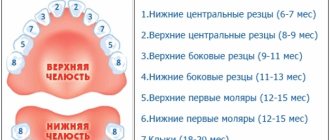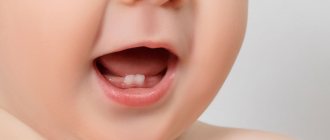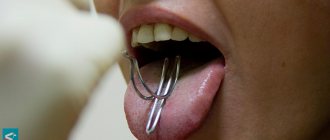Every person changes their milk teeth to molars. At 6-7 years old, the first incisor falls out, and tooth replacement ends after 20, when “eights” appear. New teeth grow according to an individual schedule, so the parent’s task is to teach the child to properly care for the oral cavity and monitor how the children’s molars grow.
Milk and molar teeth in children
Many people believe that there are no differences between permanent and temporary teeth, but this is not true. So, how to distinguish a baby tooth from a molar? At a minimum, their number differs (milk - 20, permanent, as a rule, 32). Temporary teeth have a light shade, while permanent teeth are naturally more yellow. Indigenous ones are also significantly larger in size than dairy ones - visually it is quite easy to distinguish them. Here are the most common questions asked by Internet users on this topic.
- Do children have molars?
Of course, there are, and at a certain point they begin to actively erupt. - How many molars do children have?
From 28 to 32 (the maximum set appears after all eights appear). - Which molars appear first in a child?
Typically, the lower central incisor erupts first. - At what age do children start to get their molars?
Usually, dentition renewal begins after 6–7 years, but there are no strict limits. - Do children lose molars?
By themselves - no, as a result of injuries and illnesses - yes. - What are the risks of removing a molar tooth in children?
As corny as it may sound, his loss. And yes, a new one will not grow. Everything is like adults. - What to do if a child has yellow molars?
Permanent teeth have a more yellowish tint than temporary teeth. Plaque on a child’s molars is normal, but hygiene should never be neglected. - What to do if a child has black molars?
When teething, baby teeth may have a black color (the so-called Priestley plaque, or pigment bacteria). However, this does not happen with molars. If they are black, go to the dentist immediately. - What to do if a child does not have molar buds?
This happens, but very rarely. Fortunately, with modern implantation and prosthetics technologies, the problem can be solved. - Is it normal for a child to have crooked molars?
Contact an orthodontist immediately: correcting a bite in childhood is much easier and faster than in adults. - Which teeth do children replace with molars?
All twenty, plus new molars appearing.
Anatomical differences between primary and permanent teeth
As we said above, temporary teeth differ from permanent teeth in a smaller number, as well as in significantly smaller sizes (they are 2 times smaller than permanent teeth).
At the same time, the shape of the crowns of primary teeth is always more spherical, and in the area of the neck of the primary tooth there will always be a noticeably more pronounced narrowing. In addition, temporary teeth are whiter than permanent teeth and often have a bluish tint. Differences between temporary and permanent teeth (description below) –
Anatomical differences:
- Tooth enamel – the enamel of temporary teeth is much less mineralized (saturated with minerals, primarily calcium and phosphates). Therefore, with insufficient oral hygiene, children develop caries almost instantly. In addition, the thickness of the enamel of temporary teeth is approximately 2 times less than that of permanent teeth - this circumstance leads to a very rapid transition of caries to pulpitis. There are also many microcracks and pores on the surface of the enamel of temporary teeth.
- Dentin of the tooth - the dentin layer is located under the layer of tooth enamel, and its thickness is also 2 times less (than that of permanent teeth). The dentin of temporary teeth is lighter, it is less mineralized, softer, and therefore it is much easier to prepare with a drill than the dentin of permanent teeth. Due to the fact that dentin is less mineralized and softer, the carious process in dentin spreads deeper faster, which leads to the rapid development of pulpitis in baby teeth.
- Pulp (neurovascular bundle) - some parents ask: “Are there nerves in baby teeth?” Of course, they exist, but due to the thinner layers of enamel and dentin, the pulp in baby teeth is located much closer to the surface of the tooth. The pulp chamber (tooth cavity), in which the pulp is located, is always larger in primary teeth, and therefore the pulp occupies a relatively large volume in the tooth. And besides, in baby teeth the “pulp horns” (processes) are more pronounced, which creates an additional danger of injury to the pulp during the treatment of caries.
- Roots of teeth – some parents ask: “Do baby teeth have roots?” Of course, they have roots, but they are thinner and widely spaced (at the same time, the root canals and apical openings in baby teeth are wider than in permanent teeth). But the development and growth of the rudiments of permanent teeth leads to the formation of constant pressure on the roots of primary teeth, which leads to their gradual resorption and loss. We hope that our article: Scheme of loss of baby teeth in children was useful to you!
Sources:
1. Dental education of the author of the article, 2. Based on personal experience as a dentist, 3. The European Academy of Paediatric Dentistry (EU), 4. National Library of Medicine (USA), 5. “Pediatric therapeutic dentistry. National leadership" (Leontyev).
Molars in children: symptoms of eruption
- Fever. When teething in children, body temperature may rise, usually not higher than 38 degrees.
- Itching and pain at the site where the molar appears. Various gels and ointments, as well as gum massage, will help relieve children from unpleasant sensations.
- Increased salivation and runny nose.
Important!
The growth of molars in children, especially at the initial stage, leads to weakened immunity. Take vitamins and do not forget about preventive visits to the dentist.
Formation of permanent bite
The development of molars in children begins in the prenatal period and lasts until 18–20 years, when their structure fully corresponds to “adult” parameters. That is why their condition, as well as the exact timing of eruption, depend on many factors. This:
- genetic predisposition, which is associated with metabolic characteristics;
- insufficient consumption of mineral elements in food, and we are talking about the nutrition of not only the child, but also the woman during pregnancy;
- fluoride deficiency in water and food;
- compliance with hygiene rules;
- some infectious diseases suffered by the mother (during gestation);
- insufficient functional activity of the salivary glands, since saliva contains certain substances that additionally provide mineralization of enamel, etc.
How does teething occur?
With the exception of rare cases of congenital or acquired pathologies, the appearance of molars coincides with the time of loss of milk teeth. Usually, part of the permanent tooth is already visible in this place; sometimes its growth is delayed for a short time, which is also one of the normal options.
Contrary to popular belief, temporary teeth have roots, and they differ in shape and structure from permanent ones: they can be curved and “sit” quite deeply in the gums. But as the child grows up and the rudiments of the molars grow, the “temporary” roots gradually dissolve and on an x-ray they look “eaten away”, shortened.
In this case, the pulp, where the nerve endings and blood vessels are concentrated, is replaced by granular tissue, which also participates in the resorption of the “milky” root system. And if depulpation (nerve removal) was previously performed due to injury or advanced caries, this process occurs faster.
When does a child's molars come out?
Most parents are interested in the question: at what age do children’s molars begin to erupt? The first buds form in the fifth month of pregnancy. The exact timing of their appearance has not been determined and depends on the individual characteristics of the organism. Nevertheless, an approximate scheme for the eruption of molars in children exists. If the appearance of a permanent tooth is delayed for more than six months from the extreme threshold (especially after the loss of a baby tooth), consult a specialist. The doctor will take control of the process and be able to identify complications.
What other options exist for naming a person’s teeth by numbers?
There are three other systems common among dentists that can be used to designate and record dental units:
- A universal alphanumeric system developed by the American Dental Association.
- Zsigmondy-Palmer system. One of the oldest counting systems (it was created back in 1876), it is often used in their practice by maxillofacial surgeons and orthodontists.
- Haderup system.
All of them are convenient and easy to use in their own way, and in all such systems the arrangement of teeth by numbers in adults and children is indicated differently.
Alphanumeric system
It provides an indication of not only the number of the dental unit, but also its functional purpose. Thus, incisors are designated by the letter I, canines by the letter C, premolars by the letter P and molars by the letter M. As for the numbers, they indicate the serial number of a specific functional unit in the segment (whereas in other systems the functions of the dental unit are not taken into account, only its position is taken into account in a row). For example, if according to the Viola system the wisdom tooth is numbered 8, then according to the alphanumeric system it is also designated as M3, that is, the third molar in the segment. Additionally, digital segment designations are also used, which is why the serial number becomes two-digit. The same 48th tooth mentioned more than once with such a scheme will be designated as M43.
For milk teeth, lowercase (small) Latin letters are used in the recording, and instead of numbers, sometimes letter values from A to K are also indicated, counting dental units clockwise from the upper right incisor.
Zsigmondy-Palmer system
In old, and sometimes in new dental outpatient records, you can see a special plate for recording the condition of dental units, based on the Zsigmondy-Palmer square-numeric system. The order of growth of an adult’s teeth is indicated here by the familiar Arabic numerals from 1 to 8; for children, they use Roman numerals from I to V. The numbers of the jaw segments are not indicated here, the data is simply entered into the corresponding parts of the table diagram. The system is quite convenient and visual, but in an oral conversation it can cause difficulties when indicating a specific dental unit.
Pattern of growth of molars in children
In most cases, the permanent tooth appears 3 to 5 months after the temporary tooth falls out. The order of eruption of molars is in many ways similar to the appearance of milk teeth. The first molars in children are the central lower incisors. The upper permanent teeth develop later than the lower ones, if we consider them in pairs.
| Age | Eruption of molars in children |
2 years | There have been references in history where a child was born with one or more molars. Cases when molars erupted in a 2-3 year old child also occur, but are extremely rare (less than 1%). |
5 years | When a child is 5 years old, molars very rarely come out (less than 10% of the total). If a baby tooth falls out on its own at such an early age, then there is every reason to believe that a permanent one will soon appear in its place. |
6 years | The roots of baby teeth (especially the upper and lower incisors) begin to dissolve and the teeth fall out. Usually, it is at the age of 6 that a child’s first molar begins to erupt. |
7 years | At this age, the first lower molars in children (at least one of them) have already erupted and the incisors of the upper jaw are next in line. |
9 years | At the age of 9, a child’s second molar should definitely have time to appear. Some children acquire lateral incisors and even a premolar on one of the jaws. |
10 years | At the age of ten, children’s back molars begin to actively erupt (premolars, and a little later – molars and canines). |
13 years | At 12–13 years of age, children usually develop a full bite of permanent teeth. The last teeth to emerge are usually the upper canines and second molars. This does not apply to wisdom teeth, which appear in adulthood (after 17–18 years) or may not erupt at all. |
Teething: sequence and timing
Normally, teething in babies occurs according to the scheme below:
- central incisors: at 6 months. – in the lower dentition, at 8 months. – on the upper jaw;
- lateral incisors: at 10 months. – in the top row, at 11-13 months. – on the lower jaw;
- first molars (at one year of age);
- canines in the upper row (1 year 4 months);
- canines in the bottom row (1 year 6 months);
- second molars on both jaws (2 years).
The timing of the appearance of the first teeth can vary under the influence of many factors, including:
- toxicosis during pregnancy;
- the presence of Rh conflict;
- prematurity;
- receiving intracranial injury during childbirth;
- infectious diseases;
- congenital hypothyroidism;
- rickets;
- pathology of the pituitary gland;
- neonatal sepsis;
- refusal to breastfeed the baby;
- noticeable weakening of the immune system.
It has been proven that in first-born children, teething occurs much earlier than in infants born at a later time. Boys' first teeth appear later than in girls, while in children of old-time mothers - significantly earlier than in babies born to young parents.
Complications during teething
- Delay in the appearance of permanent teeth.
This may be due to genetic characteristics, immune system problems and a number of other diseases. - Uneven teeth and other malocclusions.
- Hyperdentia.
The child’s molar tooth (or teeth) grows in the second row. Hyperdentia, or supernumerary of teeth, is a fairly rare phenomenon, but requires the intervention of a dentist to eliminate the risk of malocclusion in a child.
What complications may arise?
Baby teeth did not fall out on time. The cause of the problem must be determined by the dentist. This usually requires an x-ray. In the image, the specialist can see the degree of development of the molars.
The appearance of caries and the occurrence of pulpitis. In this case, there is a change in body temperature, the appearance of severe pain and a general deterioration in the child’s well-being.
A very common situation occurs when a molar tooth (one or more) has already begun to appear, but the milk tooth does not fall out. As a result, the new tooth will look for other ways to grow, which will lead to a change in its direction and displacement. The result is a violation of the bite and the even position of the dentition. To eliminate the problem, you will need to consult an orthodontist.
Common problems with molars in children
| Problems with molars | How to fix? |
| Molar tooth is loose | A common occurrence with injuries and bruises. To avoid tooth loss, an urgent visit to the dentist and the application of a special splint are necessary, especially if the child’s molar sways when touched. |
| Broken molar tooth | Severe chips may require orthopedic treatment. If a child's front molar has chipped, aesthetic restoration with veneers or crowns may be required. |
| Molar caries | When the first molars erupt, it is important to prevent the occurrence of caries. If this happens, then it is necessary to stop the disease in its infancy, otherwise it will affect the deeper layers of the tooth. |
| A child's molar has fallen out | The most unpleasant thing that can happen. If a child knocks out a molar along with the root, then there is a chance to save it. To do this, you need to place the knocked out tooth back into the oral cavity, saline solution or into a glass of milk and urgently rush to the dentist (you need to do it within 30 - 40 minutes after the injury). If a child’s molar tooth has been removed, then there is only one way out - installing a prosthesis. |
Care instructions
Molars in children require even more careful care than in adults. Frail enamel is much more susceptible to the effects of carious bacteria and the external environment, and the love of sweets and carbonated drinks does not add strength to it. When children develop a permanent bite, parents need to take special control of oral hygiene and diet (at least until the age of 14–15, when the teenager himself begins to realize the importance of dental health). In general, there are no difficulties here: in order to keep children's teeth strong and healthy, you need to follow several basic points.
- Daily hygiene.
Brush your teeth at least twice a day, use dental floss and special rinses. - Proper diet.
Limit your intake of sweets and carbohydrates. - Preventative visits to the dentist at least once every six months.
If necessary, fluoridation and sealing of molars in children (so-called fissure sealing). - Do not forget to wear a protective mouth guard during active games and sports.
Tips for parents
If a child is restless during teething, parents can help relieve the condition. The pharmacy sells toothache drops or special gels for topical use. It is advisable to consult a pediatrician before giving your baby medicine.
Viburkol suppositories for teething
Among the popular children's gels, Kalgel and Cholisal should be noted. These agents have a complex effect - anti-inflammatory, disinfectant, analgesic. The composition is applied to the problem area in a thin layer no more than 6 times a day. If allergic reactions occur, treatment should be stopped immediately.
Medicines used at elevated temperatures, such as Nurofen, will also help you cope with toothaches. Experienced pediatricians advise in this case to give the drug in reduced dosages (½ less than at fever) in order to achieve the desired effect and reduce the drug load on the baby’s body.
You can cope with teething pain in babies without the help of pharmacological agents. For this, you can buy special silicone teethers for your child. Typically, a cooling gel is placed inside the products. Nipples made from materials that are safe for the baby can also help cope with unpleasant symptoms.
At home, parents can organize a gum massage for the child. Manipulations are carried out with a gauze swab soaked in cold water. Also, the constant attention and care of parents can alleviate the child’s condition.











